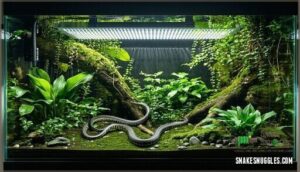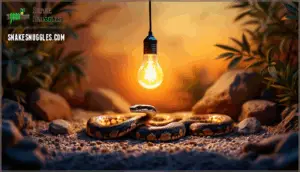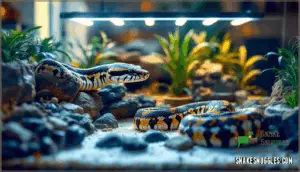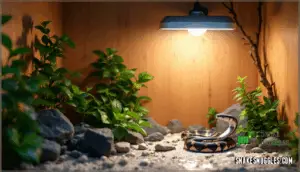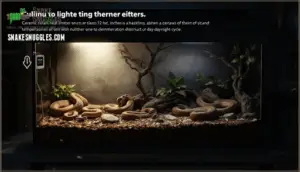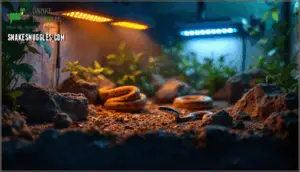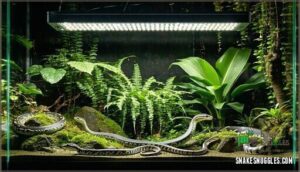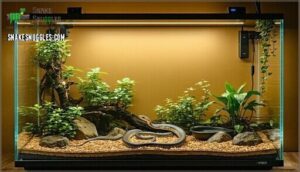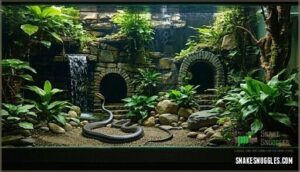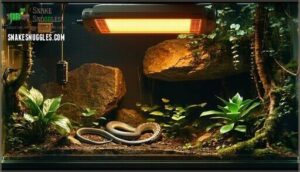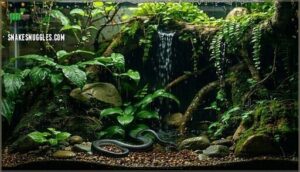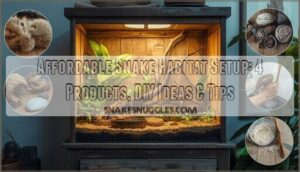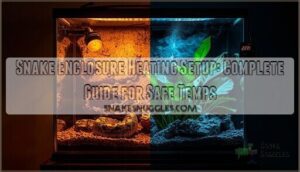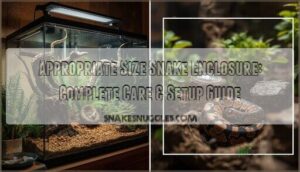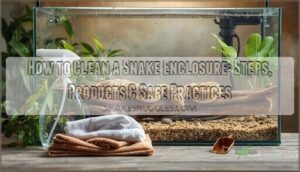This site is supported by our readers. We may earn a commission, at no cost to you, if you purchase through links.
 Your snake’s lighting setup can mean the difference between a thriving reptile and a costly vet visit. Most keepers focus on heat first and treat lighting as an afterthought. But proper illumination does more than brighten the enclosure. It regulates metabolism, triggers natural behaviors, and even strengthens bones through vitamin D3 synthesis.
Your snake’s lighting setup can mean the difference between a thriving reptile and a costly vet visit. Most keepers focus on heat first and treat lighting as an afterthought. But proper illumination does more than brighten the enclosure. It regulates metabolism, triggers natural behaviors, and even strengthens bones through vitamin D3 synthesis.
The catch is that snake enclosure lighting requirements vary dramatically between species. A spotted python thrives under conditions that would stress a ball python. Your snake’s wild habitat determines whether you need intense UVB or minimal ambient light.
Understanding these requirements before you buy your first bulb saves you from expensive mistakes and preventable health problems.
Table Of Contents
- Key Takeaways
- Choosing The Right Snake
- What Are Snake Enclosure Lighting Requirements?
- Types of Lighting for Snakes
- Importance of UVB Lighting for Snakes
- Creating a Day-Night Cycle for Snakes
- Snake Enclosure Essentials and Safety
- Heating and Lighting Options for Snakes
- Maintaining Humidity Levels in Snake Enclosures
- Creating a Naturalistic Environment for Snakes
- Safety and Security Measures for Snake Enclosures
- Frequently Asked Questions (FAQs)
- How do you light a snake enclosure?
- Do snakes need a lot of light?
- Why is lighting a snake enclosure important?
- How do I choose a lighting setup for a snake?
- How big should a snake enclosure be?
- What kind of enclosure does a snake need?
- What lights do I need for a snake tank?
- What kind of lighting do snakes need?
- How to light a snake enclosure?
- Do snakes need heat lamps at night?
- Conclusion
Key Takeaways
- Snake enclosure lighting must match the species’ natural habitat, as diurnal pythons require full-spectrum UVB for vitamin D3 synthesis while nocturnal species need minimal light with ceramic heat emitters for warmth.
- UVB lighting prevents metabolic bone disease by enabling vitamin D3 production in the skin, which allows calcium absorption from prey and maintains proper bone mineralization and muscle function.
- A consistent 10-12 hour light-dark cycle regulates your snake’s circadian rhythm, triggering essential biological processes like feeding response, shedding, metabolism, and reproductive readiness.
- Temperature gradients created by combining heat sources with proper lighting allow snakes to thermoregulate naturally by moving between basking spots (88-92°F) and cooler zones (75-80°F) as needed.
Choosing The Right Snake
Your choice of snake species directly shapes every element of your lighting setup. Different pythons have distinct lighting needs based on their natural behavior and habitat.
Let’s look at two beginner-friendly species that require specific enclosure conditions.
Spotted Pythons Characteristics
If you’re after a python that won’t outgrow your space or test your nerves, the Spotted Python might be your answer. These Australian natives reach just 3-4 feet as adults and rarely show aggression. Their gentle snake behavior makes reptile care straightforward for first-timers.
What you’ll appreciate about this species:
- Thrives in a compact snake enclosure (20-30 gallons)
- Adapts well to basic UVB lighting and heat lamp setups
- Accepts a simple python diet of appropriately sized rodents
- Tolerates moderate temperature gradients without fuss
Species research confirms their forgiving nature and manageable python habitat needs.
Children’s Pythons Characteristics
Named for British zoologist John George Children rather than young humans, the Children’s Python shares many traits with its spotted relative but carries its own subtle distinctions. This species usually reaches 3-4 feet and exhibits gentle management tips that make reptile care straightforward. Their habitat needs include a snake enclosure with UVB lighting and a proper temperature gradient. Growth rates remain steady throughout their lifespan.
| Feature | Details |
|---|---|
| Color Morphs | Brown to reddish-tan |
| Feeding Habits | Weekly rodent meals |
| Heat Lamp | Basking spot 88-92°F |
| Reptile Lighting | 10-12 hour cycle |
| Temperature Gradient | Cool side 75-80°F |
What Are Snake Enclosure Lighting Requirements?
Once you’ve picked the right python for your home, the next step is getting the lighting dialed in to keep them healthy. Snake enclosure lighting does more than light your pet’s space. It drives essential biological processes that keep your snake thriving.
Your lighting setup needs to accomplish four core functions:
- Establish proper photoperiod effects with 10-12 hours of light daily to regulate natural rhythms
- Provide UVB lighting for vitamin D3 synthesis and calcium metabolism in diurnal species
- Create thermal gradients by combining heat and light sources across the enclosure
- Match lighting intensity to your snake’s natural habitat and activity patterns
Snake vision varies by species. Day-active pythons benefit from full-spectrum reptile lighting that mimics sunlight. Night-active species need minimal UVB but still require consistent lighting cycles. Temperature gradient zones let your snake choose their preferred basking or cooling spot. Getting these elements right means your python can thermoregulate naturally and maintain healthy metabolic function.
Types of Lighting for Snakes
Choosing the right lighting for your snake enclosure means understanding the options available. Each type of bulb fulfills a different purpose in your setup. Here’s what you need to know about the five main lighting solutions.
Incandescent Bulbs
Incandescent bulbs work like miniature suns in your snake’s world. These heat lamps create cozy basking spots, delivering steady heat output that’s ideal for simple reptile lighting. You’ll find them easy to set up in any snake enclosure, though they’re less energy efficient than modern options. Watch for bulb replacement and lighting costs over time. They’re dependable, but proper wattage matters to prevent overheating.
| Feature | Details |
|---|---|
| Heat Output | High, spot-focused |
| Burn Time | Shorter than LEDs |
Fluorescent Lights
Fluorescent lights hit the ideal balance between your wallet and your snake’s wellbeing. These fluorescent options deliver essential UVB lighting while keeping energy efficiency high and your bills low. You’ll get 12 to 18 months of reliable use before needing replacements.
The light spectrum mimics natural daylight, supporting vitamin D3 production in your reptile lighting setup. Install them 12 to 18 inches above basking areas in your snake enclosure. Their color temperature creates a comfortable environment that helps regulate your snake’s daily rhythms without overheating the habitat.
Mercury Vapor Bulbs
Mercury vapor bulbs function like miniature suns in your snake enclosure. They generate both heat output and UVB emission in one package. This dual-purpose lighting setup simplifies your reptile lighting system while delivering the radiation your snake needs for healthy calcium metabolism.
Key advantages of mercury vapor bulbs include:
- All-in-one convenience – eliminates the need for separate heat and UVB lighting fixtures
- Strong UVB emission – provides adequate vitamin D3 synthesis for diurnal species
- Extended bulb longevity – usually lasts 6 to 12 months with consistent performance
- Powerful heat output – creates effective basking zones in larger enclosures
- Radiation safety – designed with controlled spectral output for reptile wellbeing
Mount them at appropriate distances to prevent thermal burns while maximizing UVB benefits.
Ceramic Heat Emitters
Ceramic heat emitters work like hidden furnaces that warm your snake’s space without producing any visible light. These units use infrared heating to create warmth without disrupting your snake’s natural day-night cycle. Nocturnal species benefit most from ceramic emitters since they maintain thermal regulation without introducing unwanted illumination during active hours.
You’ll find ceramic emitters in wattages from 50W to 150W. Pick your size based on enclosure volume and ambient room temperature. Proper emitter placement matters for creating an effective temperature gradient across the habitat. Mount them at least 12 inches above basking areas to prevent thermal burns while ensuring adequate heat distribution.
Heat emitter safety requires attention to detail:
- Always use ceramic sockets rated for high-wattage operation
- Install a thermostat to maintain consistent temperatures between 75-90°F
- Pair with reptile lighting and UVB lighting for complete environmental control
- Replace every 3-5 years despite their durable construction
- Position away from flammable substrates and decorations
These devices complement your heat lamp setup without replacing necessary UVB sources.
LED Lights
LED lights function like customizable stage lighting for your snake’s home—adjustable, efficient, and adaptable to nearly any spectrum you need. These units consume minimal power while delivering precise light intensity and color temperature control. You can adjust dimming options to match natural dawn-to-dusk transitions.
However, standard LED lights don’t produce UVB radiation. You’ll need dedicated UVB lighting alongside your LED setup to support vitamin D3 synthesis and calcium metabolism in your reptile lighting design.
Importance of UVB Lighting for Snakes
UVB lighting isn’t just a nice-to-have for your snake enclosure. It’s the key to preventing serious health problems down the road.
Here’s what you need to know about how UVB keeps your snake healthy.
Role of UVB in Vitamin D3 Synthesis
When UVB radiation penetrates your snake’s skin, it initiates a cascade that converts provitamin D3 into active vitamin D3. This process is critical for metabolic health and can’t be replicated through diet alone.
Here’s how UVB lighting facilitates vitamin D3 production:
- UVB bulbs emit wavelengths between 290-320 nanometers that trigger vitamin D3 synthesis in skin cells.
- Your snake absorbs UVB light through specialized skin receptors that activate the conversion pathway.
- Vitamin D3 production facilitates calcium absorption from food for bone development and muscle function.
- Without adequate UVB exposure, snakes develop deficiencies that compromise skeletal integrity and overall vitality.
Research on reptile care tips suggests that providing UVB lighting can be beneficial for a snake’s health.
UVB and Calcium Metabolism
Your snake’s ability to absorb calcium hinges on a simple equation: UVB exposure creates vitamin D3, which facilitates calcium absorption in the intestines. Without sufficient UVB lighting, calcium from prey passes through your snake’s gut unused—like having a locked door with no key. This metabolic regulation directly impacts bone health and muscle function.
Here’s how UVB light drives calcium metabolism in captive snakes:
| Metabolic Stage | UVB’s Role | Impact on Snake Health |
|---|---|---|
| Vitamin D3 Synthesis | UVB radiation converts provitamin D3 in skin cells | Facilitates the entire calcium pathway to function |
| Calcium Absorption | Vitamin D3 signals intestinal cells to absorb dietary calcium | Guarantees calcium enters bloodstream from food |
| Bone Mineralization | Absorbed calcium strengthens skeletal structure | Prevents fractures and metabolic bone disease |
| Muscle Function | Calcium regulates muscle contraction and nerve signals | Sustains movement and prey constriction |
| Metabolic Regulation | Balanced calcium maintains organ systems | Promotes overall vitality and immune response |
Even calcium-rich rodents won’t prevent deficiency if UVB lighting is inadequate. Your snake needs both the raw material and the metabolic tools to use it effectively. Understanding reptile care basics is essential for providing the right environment and nutrition for your pet snake.
Risks of UVB Deficiency in Snakes
Without proper UVB lighting, your snake faces three serious health threats that compound over time. The most devastating consequence is metabolic bone disease. Your snake’s bones gradually soften without adequate vitamin D3 synthesis. This happens because calcium metabolism shuts down when UVB deficiency persists. Shell deformities may appear in younger animals. Growth becomes stunted across all age groups.
Watch for these warning signs of UVB deficiency in your snake:
- Bones turn rubbery and weak, making normal movement painful
- Appetite drops sharply as metabolic disease progresses
- Lethargy replaces natural activity patterns you’ve observed before
- Unusual behaviors like glass surfing indicate neurological stress
- Fractures occur from routine touching or minor impacts
Proper UVB bulbs prevent these outcomes completely. Reptile care demands attention to lighting as much as temperature or diet.
Creating a Day-Night Cycle for Snakes
Your snake’s internal clock runs on nature’s schedule. You need to replicate that rhythm with consistent light and dark periods.
Here’s how to build a day-night cycle that keeps your snake healthy and stress-free.
Simulating Natural Lighting Conditions
Replicating your snake’s native habitat starts with matching its light spectrum and photoperiod control. A 12-hour light/12-hour dark cycle works for most species. Basking snakes need UVB intensity around 3.0–5.0 UVI in their warm zone. Your temperature gradient should range from 28–32°C at the basking spot. Shade-dwelling species require lower UVB bulbs with gentle background exposure.
Natural daylight patterns trigger feeding and shedding cycles. This photoperiodism influences breeding readiness too. Adjusting your day-night cycle seasonally—13 hours summer, 11 hours winter—mimics wild conditions and maintains your snake’s circadian rhythm.
Using Timers for Lighting Control
Automating your light cycle with a timer removes the guesswork and keeps your snake’s routine rock-solid. Digital timers let you program precise photoperiod management for consistent circadian rhythms. Your lighting setup stays stable even when you’re traveling or working late shifts.
Choose timers based on your needs:
- Basic mechanical timers manage simple day-night cycle switching at fifteen-minute intervals
- Digital programmable timers control multiple lighting cycles with minute-level precision
- Smart timers enable remote adjustments and automated seasonal photoperiodism changes
- Dual-outlet models manage UVB and heat lighting independently for ideal circadian rhythm support
Benefits of a Consistent Lighting Schedule
Once you set your timer and forget about it, your snake settles into a rhythm that makes everything from digestion to shedding run like clockwork. Stable circadian rhythms regulate biological cycles that control feeding response and metabolic efficiency.
Photoperiodism influences reproductive readiness, while behavioral enrichment improves through predictable activity windows.
Your snake’s immune function strengthens when light therapy aligns with natural photoperiod patterns. Temperature gradient use becomes more purposeful during established day-night cycles.
Snake Enclosure Essentials and Safety
Your snake’s home needs more than just the right light. A proper enclosure provides security and comfort while supporting natural behaviors.
Let’s look at the three core elements that make any snake habitat safe and functional.
Selecting a Suitable Enclosure
Think of a snake enclosure like a custom-tailored suit—one size never fits all, and the wrong fit can lead to stress, escape attempts, or health problems down the line. Your enclosure design and setup must match your snake’s adult length and behavior patterns.
A proper snake enclosure needs dimensions at least equal to your snake’s full body length. This allows natural movement and proper temperature gradient establishment. Tank materials matter too—glass and PVC both offer excellent climate control when paired with appropriate ventilation systems.
Essential enclosure features include:
- Escape-proof lids with secure locking mechanisms
- Adequate dimensions matching adult snake size requirements
- Smooth interior surfaces preventing scale damage
- Strategic placement for reptile lighting and heating installation
- Snake hiding spots supporting natural behavioral needs
Ensuring Proper Ventilation
Without proper ventilation, your snake enclosure becomes a stagnant box where stale air, excess humidity, and harmful ammonia can threaten your pet’s respiratory health. Install ventilation systems with openings on opposing sides to establish fresh air flow throughout the enclosure. This air exchange maintains your temperature gradient while preventing moisture accumulation that disrupts the day-night cycle effects.
Monitor your snake’s behavior as your best ventilation gauge. Frequent glass-rubbing or excessive time near vents signals airflow problems requiring adjustment.
| Ventilation Feature | Purpose | Implementation |
|---|---|---|
| Top mesh panels | Heat and moisture escape | Cover 20-30% of lid area |
| Side vents | Cross-ventilation and air exchange | Position on opposite walls |
| Screen material | Humidity control while allowing airflow | Use fine mesh for small species |
| Adjustable openings | Custom enclosure aerodynamics | Slide panels or removable sections |
| Strategic placement | Maintain proper ventilation without drafts | Avoid direct reptile lighting interference |
Using Substrates and Decorations
Your substrate choice sets the foundation for everything else in your snake’s world—from how well they shed to where they feel safe enough to rest.
Consider these substrate options for your terrarium setup:
- Coconut fiber or coco husk retains moisture for humidity management while supporting bioactive systems
- Aspen shavings provide excellent burrowing material for species requiring lower moisture
- Cypress mulch balances humidity retention with natural aesthetics
Add climbing structures and decorative rocks to create vertical space. Visual hides and water features complete your snake enclosure by supporting thermoregulation and reducing stress through proper substrate selection.
Heating and Lighting Options for Snakes
Setting up heating and lighting means making smart choices about equipment and placement. Your snake needs the right heat source and proper light fixtures to stay healthy.
The goal is to create zones where your snake can move between warmer and cooler spots as needed.
Choosing The Right Heat Source
Heat sources don’t just warm your snake – they power every biological function from digestion to immune response. Ceramic heat emitters provide steady infrared heat without light. Heat mats create gentle warmth from below. Radiant heat panels mimic the sun’s thermal regulation. Heat lamps combine visible light with heating. Match your choice to your species’ needs and enclosure dimensions.
| Heat Source | Best For |
|---|---|
| Ceramic Emitters | Nighttime heating without disturbing sleep cycles |
| Thermal Mats | Ground-dwelling species needing belly warmth |
| Heat Lamps | Diurnal snakes requiring basking spots |
| Infrared Heaters | Large enclosures needing ambient temperature control |
Installing Proper Lighting
Proper installation transforms a collection of bulbs and fixtures into a functional life-support system that keeps your snake thriving year-round. Your lighting design should balance UVB options with heat sources while avoiding thermal hotspots. Here’s your installation roadmap:
- Position UVB lighting and ceramic heat emitters at manufacturer-recommended distances
- Mount reptile lighting fixtures on opposite enclosure ends to distribute heat evenly
- Connect timer systems to automate lighting cycles without manual intervention
- Install LED lights separately from heat sources to prevent electrical interference
This setup guarantees your snake receives proper UVB light exposure while maintaining safe temperatures throughout the enclosure.
Creating a Temperature Gradient
A temperature gradient in your enclosure acts as a silent thermostat that lets your snake decide when to warm up or cool down on its own terms. Position your heat source on one end to establish distinct thermal zones. This creates a basking spot around 88-92°F while the cool side stays near 75-80°F.
Your snake will shuttle between these areas throughout the day for proper thermoregulation. Monitor both zones with separate thermometers to maintain stable heating and temperature control.
Maintaining Humidity Levels in Snake Enclosures
Humidity control isn’t just about adding water to your snake’s enclosure. It’s about creating a stable environment that promotes healthy shedding and respiratory function.
Here are three proven methods to maintain proper humidity levels.
Incorporating Misting Systems
Misting systems work like scheduled rain showers for your snake’s home. They deliver precise humidity control without disrupting temperature or lighting cycles. Automatic misters pair with timers to create consistent moisture levels. You can adjust water spray timing to match your species’ needs. Fogging equipment works differently than direct sprays.
- Programmable timers trigger misting during cool periods to avoid interfering with thermal regulation
- Reservoir capacity determines how often you’ll refill the system
- Nozzle placement creates even coverage across your snake enclosure
- Pressure settings control droplet size and spray distance
- Dual-zone systems maintain different humidity levels in one enclosure
Using Humidity-Retaining Substrates
Once you’ve got your misting system dialed in, the substrate you pick becomes your 24/7 humidity partner. Coco fiber and similar bioactive mixes hold moisture without turning swampy. Aspen bedding works for drier species but won’t give you the humidity control tropical snakes need.
| Substrate Type | Moisture Retention |
|---|---|
| Coco Fiber | High – ideal for tropical species |
| Aspen Bedding | Low – suits arid-climate snakes |
| Bioactive Mixes | Moderate to High – facilitates naturalistic terrarium setup |
Layer substrate 2-3 inches deep across your snake enclosure for consistent humidity levels.
Monitoring Humidity Levels
You’ll want to check those numbers throughout the day to catch problems before they affect your snake. Record your readings twice daily to spot evaporation rates and water cycling patterns. Consistent monitoring protects humidity levels and snake health from sudden shifts.
Place your hygrometer at multiple heights to track how moisture management varies from substrate level to basking zones. Digital models with remote sensors give you real-time humidity control without opening the enclosure.
Temperature and humidity control work together—warmer areas dry faster and cooler spots hold moisture longer.
Creating a Naturalistic Environment for Snakes
A naturalistic enclosure doesn’t just look good—it fosters your snake’s physical and mental health. The right decorations provide hiding spots and climbing opportunities while reducing stress.
Here’s how to design an environment that mirrors your snake’s natural habitat and encourages healthy behaviors.
Adding Decorations and Enrichment
Think of your snake’s enclosure as a canvas where every branch, hide, and texture becomes a tool for natural behavior. Climbing structures like cork bark and decorative rocks create vertical opportunities for exploration. Multiple hiding spots reduce stress and encourage natural retreat behaviors. A shallow water dish facilitates hydration and soaking during shed cycles. Textured surfaces provide sensory stimulation and aid in sloughing old skin.
These environmental enrichment elements transform a basic snake enclosure into a vibrant terrarium lighting setup that promotes physical activity and mental engagement. Thoughtful reptile lighting paired with strategic enrichment mimics wild habitats effectively.
Incorporating Live Plants
Live plants serve as living air filters that regulate moisture while boosting oxygen levels in your snake’s enclosure. Choose sturdy plant species like pothos or sansevieria that tolerate your UVB lighting and terrarium lighting conditions.
Verify soil quality sustains root systems without creating bacterial risks. Position plants strategically for humidity control while preventing damage from your snake’s weight. Secure containers prevent uprooting during movement.
This reptile lighting setup paired with greenery creates functional zoo lighting aesthetics.
Creating Visual Barriers
Visual barriers turn your snake’s enclosure from an empty box into a space where stress melts away. Strategic placement of visual hides and barrier materials creates secure zones that support natural behaviors. Your reptile lighting and heating setup works better when combined with proper enclosure design and setup elements.
Consider these barrier materials for your snake enclosure:
- Cork bark slabs lean against walls to create dark retreats under UVB lighting
- Plant decor like artificial vines soften harsh sight lines between zones
- Rock formations stack securely to form caves and climbing surfaces
- Screen enclosures within the habitat separate basking areas from cool zones
These elements help your snake feel protected while maintaining your lighting setup’s effectiveness.
Safety and Security Measures for Snake Enclosures
A secure enclosure isn’t just about keeping your snake contained. It’s about preventing escape and protecting both your pet and household.
Here are three critical safety measures every snake keeper needs to implement.
Installing Escape-Proof Lids and Locks
Even the most docile snake will test every gap and seam in its enclosure if given the chance. Your snake tank setup demands secure lids that withstand persistent pushing and probing. Proper ventilation must work alongside enclosure safety features without creating weak points. Strong locking mechanisms provide the backbone of escape prevention.
- Install sliding glass tops with spring-loaded latches that lock automatically
- Use key-operated locks on hinged enclosure doors for added security
- Choose secure lid designs with reinforced edges that resist warping over time
These ventilation systems maintain airflow while keeping your snake safely contained.
Sealing Potential Escape Routes
Snakes are patient escape artists that will probe every corner of their habitat for weaknesses you didn’t know existed. Your snake enclosure demands thorough escape proofing beyond secure lids alone.
Check mesh screens for loose corners where silicone sealant can reinforce connections. Cable holes for heating elements often create gaps around wires that need foam gaskets or weatherstripping. Panel joints may warp over time and require fresh sealant materials to maintain integrity.
Even tiny openings compromise enclosure requirements because snakes can squeeze through spaces smaller than their head. Test every seam by running your fingers along edges while checking for gaps. Your snake tank setup needs locking mechanisms paired with proper ventilation that doesn’t sacrifice security.
Regular inspections catch new weak points before enclosure reinforcement becomes urgent.
Implementing Double-Door Entry Systems
Your double-door system works like a bank vault’s vestibule—one door closes before the next opens, creating a fail-safe barrier between your snake and freedom. This design prevents escape during routine snake care activities and lighting setup adjustments. The outer door provides access control systems, while the inner door contains your snake during maintenance.
Key benefits of the double-door design:
- Prevents escape when checking UVB light fixtures
- Allows safe access for adjusting snake lighting schedules
- Creates secure entry points for feeding sessions
- Integrates with locking mechanisms for maximum security
- Reduces stress by minimizing direct habitat disturbance
This escape prevention method meets critical reptile lighting needs while maintaining safety protocols.
Frequently Asked Questions (FAQs)
How do you light a snake enclosure?
Proper lighting design goes beyond just flipping a switch. Position UVB light and ceramic heat emitters to create distinct thermal zones.
Use timers to control photoperiod and maintain lighting cycles that mirror your snake’s natural habitat. Match color temperature and lighting setup to your species’ reptile lighting needs while considering snake vision sensitivity.
Do snakes need a lot of light?
Most snake species don’t need intense light. Lighting needs vary by species. Diurnal snakes need 10-12 hours of photoperiod daily, while nocturnal species require minimal visual stimulation.
UVB light regulates circadian rhythms regardless of activity patterns. Match your lighting setup to your snake’s natural day-night cycle.
Why is lighting a snake enclosure important?
Without proper lighting benefits, your snake faces serious health outcomes. Light facilitates thermal regulation and photoperiod cycles that drive snake behavior.
UVB light allows vitamin D3 synthesis for calcium metabolism, while visual stimulation and environmental impact shape activity patterns and digestion.
How do I choose a lighting setup for a snake?
Match bulbs to your snake’s habitat. Diurnal species need full-spectrum UV light for vitamin D Nocturnal ones thrive with ceramic heat emitters.
Combine heat sources with lighting cycles that mirror natural temperature variation for ideal enclosure design.
How big should a snake enclosure be?
Choose tank dimensions that match at least two-thirds of your snake’s adult length. Height matters too for climbing species.
Space requirements depend on snake species and natural habitat simulation. Your enclosure setup should allow full body extension plus room to explore different zones.
What kind of enclosure does a snake need?
A snake’s home isn’t just four walls—it’s their whole world. You’ll need a secure enclosure with proper ventilation systems and escape-proof secure lids to keep your snake safe.
Inside the snake tank setup, include hiding spots for security and climbing structures for enrichment. Install proper heating and lighting to maintain temperature control. Add a water dish and choose substrate that suits your species.
The right enclosure requirements create a complete lighting setup and comfortable environment for your snake.
What lights do I need for a snake tank?
Tank illumination depends on whether your snake is diurnal or nocturnal. Diurnal species need UVB fluorescent bulbs combined with heat lamps for proper lighting cycles and temperature gradients.
Nocturnal species require minimal lighting with ceramic heat emitters providing warmth without disrupting their natural behavior.
What kind of lighting do snakes need?
Most captive snakes need UVB lighting for vitamin D3 synthesis and proper calcium metabolism. The lighting spectrum affects snake vision and overall reptile health in enclosures.
Basking lights create thermal regulation zones while ambient illumination maintains your snake’s natural photoperiod control.
How to light a snake enclosure?
Install UVB fluorescent lights along one end to support vitamin D3 synthesis and establish your photoperiod control. Combine them with heat lamps to build thermal gradients across the enclosure. Ceramic heat emitters provide nighttime warmth without disrupting snake vision or ambient illumination patterns.
Do snakes need heat lamps at night?
Nocturnal snakes often don’t need heat lamps at night if room temperatures stay stable. Ceramic heat emitters provide thermal regulation without disrupting the dark period.
Maintain a thermal gradient so your snake can thermoregulate. Stable nighttime temperatures support natural snake activity patterns and preserve the critical day-night cycle.
Conclusion
A wild-caught python once arrived at a research facility with severe metabolic bone disease. The keeper had provided heat but skipped UVB entirely. Within months of proper lighting, the snake’s condition stabilized.
Your snake enclosure lighting requirements aren’t optional extras. They’re the foundation of long-term health. Match your bulb choice to your species’ natural habitat. Install timers to maintain consistent day-night cycles. Monitor UVB output every six months. These simple steps prevent expensive health crises and give your snake the conditions it evolved to need.
- https://reptilesandresearch.org/articles/do-snakes-need-uvb
- https://reptifiles.com/ball-python-care-guide/ball-python-humidity-temperatures/
- https://arcadiareptile.com/lighting/guide/
- https://talis-us.com/blogs/news/the-importance-of-snake-lights-providing-proper-lighting-for-your-snake
- https://www.zenhabitats.com/blogs/reptile-care-sheets-resources/corn-snake-complete-lighting-and-heating-guide

